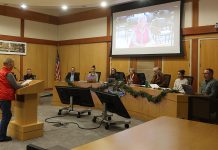A weeklong Thanksgiving vacation and two four-day weekends are
among the changes to next year’s calendar for Healdsburg’s public
schools, cuts officials say will save more than $250,000 in the
coming year.
The Healdsburg Unified School District Board of Trustees
approved the extended Thanksgiving break, a four-day Veterans’ Day
weekend and another four-day weekend next March at its last
meeting. The district estimates it will save $52,000 for each
eliminated day, savings that will come directly out of staff
paychecks, utility costs and other operating expenses.
“We’re using a wide variety of strategies to save over $2
million next year, and that includes reducing the school year,
increasing class size and eliminating positions,” said district
superintendent Jeff Harding. “Next year’s school year is 175 days.
We’ve had 180 as long as I can remember.”
California’s Education Code once required public schools to
provide students with at least 180 days of instruction each year.
“For many years, 180 days was the gold standard,” said Carl Wong,
Sonoma County’s Superintendent of Schools. “Then the Ed Code was
amended to allow districts to drop below 180 instructional days” to
maintain a balanced budget during the state’s ongoing fiscal
crisis.
Wong said Healdsburg is not alone among Sonoma County school
districts in cutting days to balance the books. “I’m seeing
districts reducing between three and five days,” he said.
Most of the savings from fewer days comes at the expense of
employees, many of them teachers. Barbara Pinney, a science teacher
at Healdsburg Junior High and a representative of the teacher’s
union, said the cuts are unpopular yet necessary. The Healdsburg
Area Teachers Association voted in favor of fewer school days prior
to the calendar’s release. On average, a teacher will lose
approximately $300 for each missed day next year.
“It was a tough sell,” she said. “[The California Teachers
Association] went through the district’s budget, and there’s really
no other solution.”
Another alternative was to increase class sizes, a move that
could save some instructional days but would mean more teachers
would lose their jobs. “Preserving people’s jobs is what sells
[fewer days],” said Pinney. “The vote was overwhelmingly yes. At
this point we still have at least 10 full-time teachers who have
been RIFed (laid off) and have not brought back yet.”
With the deal made, Pinney said the upcoming year will be tough
on teachers. By extending Veterans’ Day weekend—the state already
gives students Thursday off, so the district added the Friday after
an auditor projected it would be a low attendance day—and
Thanksgiving break, students will have two long breaks in November.
Then comes winter break just three weeks later.
“In November and December we hardly teach at all,” said Pinney.
“It’s ridiculous. The lack of continuity is really
frustrating.”
She also noted that a week less of class time would mean less of
the curriculum could be covered. “We don’t have enough time as it
is to teach what we need to teach,” she said.
The third “budget cut” four-day weekend is isolated in March on
the 18-21, a full month before spring break.
Harding said the days off were selected after an auditor
investigated the district’s attendance trends and identified time
periods that historically have low attendance. “We wanted to
minimize the impact,” he said. “If there are fewer students and
it’s right before a vacation, we tend not to be as efficient as we
are on other days.”
He also acknowledged that eliminating days would hurt the
district’s academics. “It has a negative impact on our
instructional program,” he said. “Every day counts. This was a last
resort in a time of crisis in order to balance the budget.”








